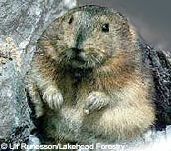Alaska Fish & Wildlife News
September 2003
Hair Snares and Detective Work
DNA Offers Police and Biologists Valuable Insights

When brown bear researchers Steve Lewis and LaVern Beier checked the 200 bear traps they set on Northeast Chichagof Island this summer, they discovered they had 97 successful captures. But they didn't wrangle a single bruin.
The bears escaped - as planned, without even noticing they'd been snared - but they left woolly brown hair in the traps. Like a burglar leaving his driver's license at the scene of a crime, that hair tells biologists exactly who was there. Alaska Department of Fish ...
Snaring DNA ArticleContinued
Lemming Suicide Myth
Disney Film Faked Bogus Behavior

Lemmings do not commit mass suicide. It's a myth, but it's remarkable how many people believe it. Ask a few.
"It's a complete urban legend," said state wildlife biologist Thomas McDonough. "I think it blew out of proportion based on a Disney documentary in the '50s, and that brought it to the mainstream."
Lemmings are a kind of short tailed vole, a mouse-like rodent that favors tundra and open grasslands. Three kinds are found in Alaska, including the collared ...
Lemming Myth ArticleContinued
Moose, Black Bears and Goshawks
All in a Day's Work for Wildlife Biologists

It's 8:15 a.m. and Jessy Coltrane, assistant area biologist in Anchorage, is outside my office door.
"Want to come look for moose?" she asks, glancing at my clothes, with a large mug of coffee in her hand.
She had on her everyday Fish and Game garb - Carhartts and boots. It's not hard to visualize Jessy, a petite but athletic woman, responding to calls about bears in dumpsters and calming residents' fears of marauding moose.
Jessie came to the department with ...
Biologists at Work ArticleContinued
Alaska's Familiar Marmot is an Ice Age Colonist

The shrill whistle of the hoary marmot is a familiar sound to Alaskans, especially to hikers with dogs. But on the hot, calm afternoons that can grace Alaska in the summer, the green alpine slopes can be pretty quiet. The alarm call of the marmot colony is silent.
Marmots are designed for cold, with thick fur and ample body fat. They can't sweat or pant to dispel excess body heat, so they avoid overheating on summer afternoons by retreating to the cool, mosquito-free darkness of their burrows, ...
Ice Age Marmots ArticleContinued
